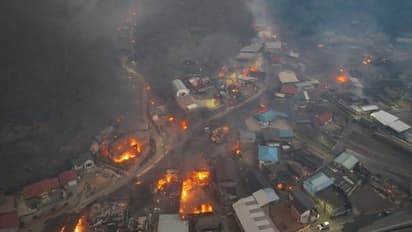South Korea wildfires kill 18, injure several; helicopter crashes during firefighting efforts (WATCH)

Synopsis
A firefighting helicopter crashed in Uiseong as South Korea battles its worst wildfires in years. The blazes have killed 18, injured 19, destroyed 200+ structures, and forced 27,000 to evacuate. Crews fight strong winds to contain the fires.
A firefighting helicopter crashed while battling the devastating wildfires in Uiseong, a southeastern town in South Korea, officials confirmed Wednesday. The Korea Forest Service stated that rescue operations were ongoing and that the helicopter was believed to have been piloted by a single operator with no additional crew members.
Meanwhile, the wildfires continue to wreak havoc across South Korea’s southern regions, marking one of the worst fire disasters in the country’s history. The blazes have already claimed at least 18 lives, left 19 injured, and destroyed over 200 structures, including homes, factories, vehicles, and the historic Goun Temple, a 1,300-year-old Buddhist site.
Also read: 'Yemen strike messages contained no classified intel': Tulsi Gabbard
Wildfires fuelled by strong winds force mass evacuations
According to Yonhap News Agency, the wildfires, which started last Friday in Sancheong County, South Gyeongsang Province, have rapidly spread to Uiseong, Andong, Cheongsong, Yeongyang, and Yeongdeok, fueled by strong, dry winds. Thousands of residents have been forced to flee, with over 27,000 people evacuated from affected areas.
The flames have now consumed 43,330 acres of land, making them the third-largest wildfires in South Korea’s history in terms of land burned. Authorities remain on high alert, as unpredictable wind patterns continue to hamper firefighting efforts.
Also read: Meta introduces ad-free subscriptions in Europe amid regulatory pressures
Death toll rises as rescue operations continue
Authorities have confirmed 18 fatalities, with one person still missing in Cheongsong. The distribution of casualties is as follows:
Yeongdeok: 7 dead
Yeongyang: 6 dead (including 4 victims found burnt on a road late Tuesday night)
Cheongsong: 3 dead, 1 missing
Andong: 2 dead
Additionally, 10 people have been injured, including two in critical condition.
Government deploys full-scale response
Acting President Han Duck-soo described the situation as “the worst wildfires ever” and called for an all-out effort to contain the disaster. Speaking in a televised address, he warned of unprecedented damage and directed emergency teams to concentrate all resources on firefighting and rescue operations.
Despite 4,650 personnel, including firefighters, soldiers, and emergency workers, being on the ground with 130 helicopters and fire engines, strong overnight winds have made containment efforts extremely challenging. Officials are hoping that 5-10 millimeters of rainfall, expected on Thursday, will aid firefighting efforts.
Prison evacuations and large-scale military assistance
In response to the spreading fires, South Korea’s Justice Ministry evacuated around 500 inmates from a prison in North Gyeongsang Province to another facility. Initially, the government planned to relocate 3,500 prisoners, but as some fires were extinguished, the number of transfers was reduced.
Since Friday, the South Korean military has deployed 5,000 personnel and 146 helicopters to assist in fire containment efforts.
Historic Buddhist temple destroyed, but national treasures safe
Among the significant losses is Goun Temple, an ancient Buddhist monastery built in 681 during the Silla Dynasty. While the temple itself was destroyed, officials confirmed that national treasures housed there had been moved to a secure location before the fire engulfed the site.
Also read: 'Just let him pee': Mother lets toddler urinate into restaurant glass in China
Ongoing threat and future outlook
As firefighting operations continue, authorities warn that changing wind patterns could reignite fires in areas previously thought to be under control. The scale of destruction, loss of life, and damage to cultural heritage sites has placed immense pressure on emergency responders.
With thousands of firefighters and military personnel still battling the blazes, South Korea faces a critical test in managing what has now become one of its deadliest wildfire disasters in modern history.